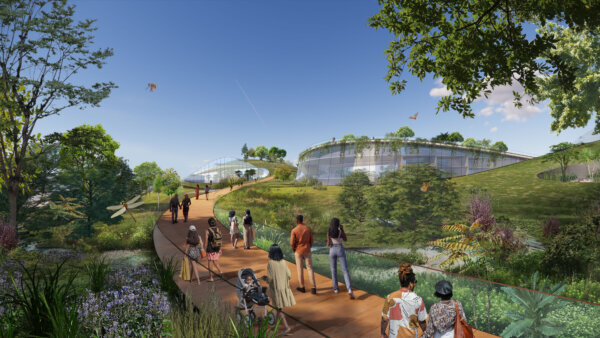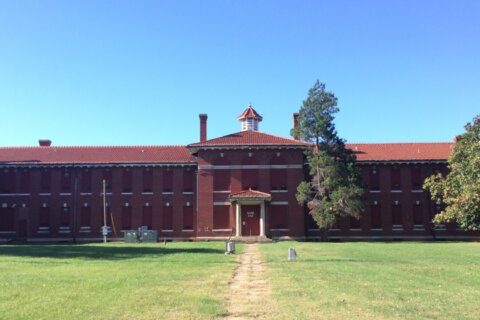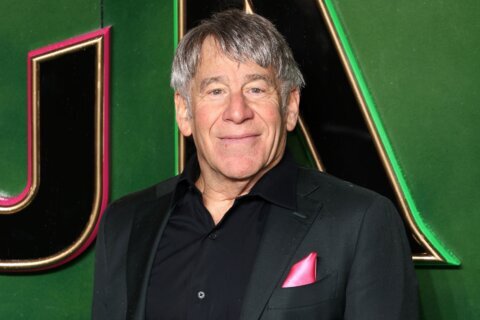Last month, Mayor Muriel Bowser announced D.C. had inked a deal with a company seeking to build a massive $500 million complex in the District. No, it’s not for a new Commander’s stadium or swanky hotel.
The agreement is with an Austrian-based company that hopes to build an indoor spa and water park the size of 10 baseball fields somewhere in the nation’s capital.
The exclusive deal Bowser announced called for a one-year period in which the Therme Group would only consider locations in D.C. — not anywhere else in Virginia, Maryland, West Virginia or Pennsylvania — for its next “Therme” spa.
D.C. officials hail the potential project as a key part of D.C.’s “comeback” from post-pandemic economic uncertainty and the idea has support from some local business leaders.
But, a month into the exclusive agreement, WTOP’s DMV Download podcast digs into the deal: Just what is a Therme? Where is there space to build one in D.C.? And who is going to pay for it?

‘Modern-day Roman baths’
If this is the first time you’ve read the word Therme (pronounced ‘therma’) — you’re not alone.
After two hours of asking dozens of people walking past the Dupont Metro station this weekend, not a single person seemed know what a Therme is.
“No, no, what is that?” longtime D.C. resident Alex said when asked.
“No — it sounds interesting though,” fellow resident Torrey echoed.
Chief Development Officer at Therme Group US Omar Toro-Vaca is overseeing the possible construction of a D.C. Therme.
“We think of ourselves as modern-day Roman baths,” Toro-Vaca said. “We’re definitely the antithesis to the metaverse” referencing a recent push by tech giants for virtual reality experiences.
Therme, Toro-Vaca says, is about a physical experience.
“Coming together, having a kind of ritual around wellness that is intentional, that gives you access to different aspects of the well-being process, whether it’s for mental health or physical health or a combination of the two,” he said.
When pressed for a more concrete image, Toro-Vaca went on.
“I really want people to think of Therme as an urban oasis, the kind of place that is unlike most experiences in the modern day American city,” he said.
As an example, he pointed to the company’s newest location in Bucharest, Romania.
If you’re thinking of something that’s a cross between a regional mall and a thermal bathhouse, you’re on the right track.
But for Toro-Vaca, it’s much more than that.
‘Dawning of a new era’
Therme finds its origin in Josef Wund — a prominent German architect and entrepreneur — who dedicated much of his life to building bathhouses in Germany and promoting thermal bathing as key to a healthy life.
To Toro-Vaca, Therme is about “increasing exposure to some things that, maybe, are ancient and have long been forgotten or set aside in order to privilege medical or pharmaceutical solutions.”
Thermal bathing has a long history dating back to the times of Homer, Plato and Cleopatra — who all referenced using hot springs. During the Roman Empire, bathhouses were a core fixture of society. But after that, the practice fell out of popular favor, though remained a regular practice in some regions like Finland.
Recently, saunas and bathhouses have gotten more popular and become the subject medical study, some of which concluded regular thermal bathing can help with cardiovascular health and stress.
“It really is the dawning of a new era, if you will, where we are putting one’s individual mental and physical health ahead of the preoccupations that most people have,” Toro-Vaca said.
‘Wellness at scale’
Sounds nice, but where will a Therme — the size of 10 baseball fields — fit in D.C.?
Currently, the old RFK stadium site in Northeast D.C., and Poplar Point, the 110-acre piece of land on the east side of the Anacostia River, are the top two contenders with a preference toward the latter option, Toro-Vaca said.
Sitting just across the Anacostia River from Nationals Park, Poplar Point has the space and waterfront access — a key feature for Thermes across the world.
Securing the site won’t be easy since it’s federally owned. But just five days after signing an agreement with Therme, the city started the long bureaucratic process of gaining ownership of Poplar Point.
“Poplar Point is an opportunity to further our claim as a waterfront city,” said Interim Deputy Mayor Keith Anderson, the co-signer of the Therme agreement. “This project has had a long history of starts and stops, but by hiring an owner-representative to continue to work toward the requirements for the transfer, we are creating momentum.”
The city did not explicitly endorse a Therme on Poplar Point. Instead stating that as they work to gain ownership of the green space, they’ll determine how to use it going forward. In a statement to WTOP, potential land uses include residential, retail, office, entertainment, cultural and park sites.
‘Therme would fund the building costs’
If land is secured, building a Therme in D.C. would cost around $500 million and take two years, Toro-Vaca estimated. But the city wouldn’t spend a dime on construction.
“Therme would fund the building costs,” he said.
It’s an offer that stands in stark contrast to formerly proposed deals for a new Commanders stadium where municipalities had to offer hundreds of millions of dollars toward development.
Further, Toro-Vaca argued a Therme would offer better tax and employment benefits than a professional sports stadium.
“We have significantly more tax revenue to contribute than an arena or a ballpark because we’re open 365 days a year and operate 12-16 hours a day,” Toro-Vaca said. “And lots of jobs in very interesting areas for growth and for personal fulfillment that we hope will be attractive to many communities.”
A ticket to a completed Therme would be around $45 — a price Therme promotes as an affordable alternative to spas that can cost up to $150.
“It’s part of a larger discussion about the role of urban development in helping improve urban conditions for everybody,” Toro-Vaca said. “We’re trying to lower the barriers to entry and make sure that as many people can come to Therme as possible.”
To recap, Therme is offering to build the site with no cost to the city, and to generate jobs and tax revenue — and is even floating the idea of making entry free for local residents.
A look at Therme’s backers
But who is paying for all this?
Currently, Therme operates only four active wellness centers around the world, but it is building five more Thermes across the globe. In addition to taking a look at D.C., the company is actively searching for more locations. With each Therme costing around $500 million, this Austrian company has financial backers with deep pockets.
Toro-Vaca said Therme is funded by A-Heat, a Germany-based manufacturer of large-scale HVAC equipment and heat exchanger technology with international operations. The conglomerate is not publicly listed and it’s financial backers are private.
When asked why A-Heat is investing likely billions into this wellness company, Toro-Vaca pointed to Therme’s technology.
“Much of the technology was invented and refined by A-Heat,” he said. “They invest in building types that demonstrate their technological innovation.”
Another possible fund source is Impact One, an investment initiative that represented Therme at the World Economic Forum this past spring. At the meeting, Therme penned a deal with the World Economic Forum with the goal of “advancing a conscious, quality-oriented approach to the planning, construction and management of buildings, infrastructure, public spaces and landscapes.”
In short, Therme has heavy investment, but it remains unclear where, exactly, that money comes from.
When asked specifically about funding sources, the mayor’s office had no response.
‘Curious how it turns out’
Despite not knowing much about Therme, the dozen or so residents walking past the Dupont Metro station were intrigued by the idea.
“I’m a great fan of baths,” Alex said. “I’ll be there. And I’ll be curious how it turns out.”
But the path between a theoretical Therme and the construction of massive wellness center in D.C. is long.
For instance, will D.C. residents want to pay $40 to walk into a humidified wellness center when they can easily walk in Rock Creek Park for free?
Toro-Vaca thinks so.
“A lot of it is willpower, and it comes down to individuals and working with community to captivate their imagination,” Toro-Vaca said.








